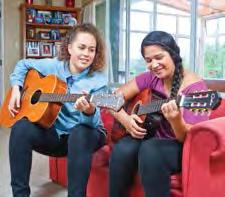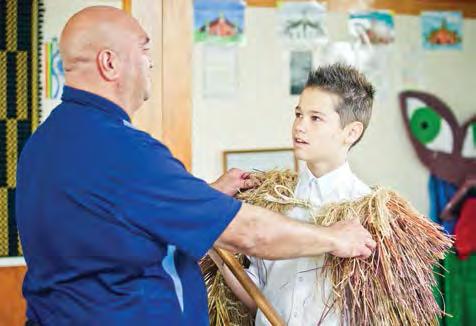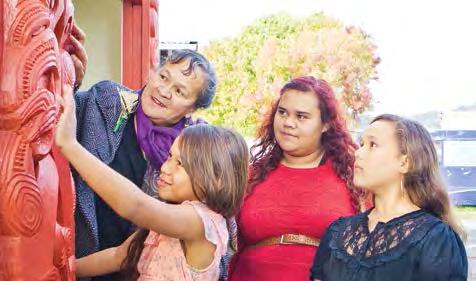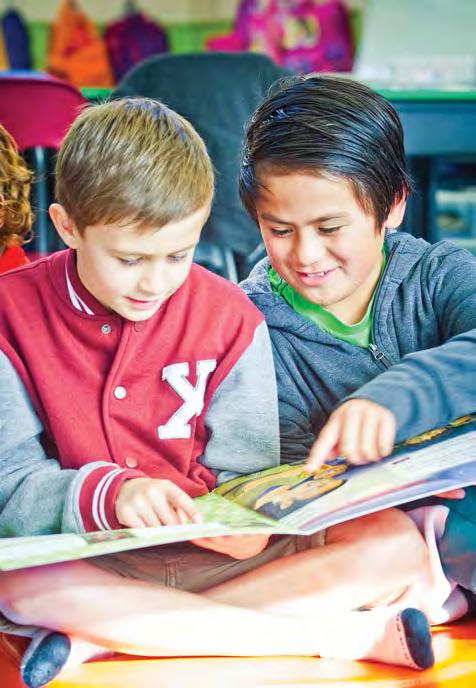
17 minute read
Ko te ara matua: The strategic context for Mäori language in education
Ko te ara matua:
Advertisement
Introduction
Mäori language in education is a defining feature of Aotearoa New Zealand’s education system. The education sector needs to create Mäori language opportunities for learners. Every Mäori learner should be able to access high quality Mäori language in education. In addition, for the Mäori language to flourish the language needs to be supported and revitalised both within education and in communities.
High quality Mäori language in education is important because it:
supports identity, language and culture as critical, but not exclusive, ingredients for the success of all learners
provides all Mäori learners the opportunity they need to realise their unique potential and to succeed as Mäori
gives expression to the national curriculum documents for early learning, primary and secondary schooling, which recognise the importance of te reo and tikanga Mäori for Aotearoa New Zealand
supports community and iwi commitments to Mäori language intergenerational transmission and language survival. As an official language, the Mäori language offers cognitive, cultural, educational, economic, social and linguistic benefits for all New Zealanders. These benefits support the development and celebration of our national identity, while at the same time protecting the distinctiveness of the indigenous people, increasing family and whänau (and community) cohesion, and contributing to economic opportunities.
The vision for Tau Mai Te Reo is ‘Kia tau te reo – Supporting Mäori language in education: delivering strong, coordinated effort and investment’. Tau Mai Te Reo expresses and encourages a way of working that enacts Government and the education sector responsibilities relating to both the Treaty of Waitangi and Te Rautaki Reo Mäori – the Mäori Language Strategy. Responsibility for the revival of the Mäori language is shared between iwi, Mäori, the Crown and its agents. Mäori language can not be made secure by Mäori efforts alone, nor Crown efforts alone. It depends on the ability of both sides to cooperate, participate and contribute.
Tau Mai Te Reo builds on the Mäori language in education elements of Ka Hikitia – Accelerating Success 2013–2017. Tau Mai Te Reo recognises the importance of iwi and Mäori participation, contribution and partnership to strengthen Mäori language in education consistent with Whakapümautia, Papaköwhaitia, Tau ana – Grasp, Embrace, Realise: Conducting Excellent Education Relationships.
Journey of Mäori language in education
While Tau Mai Te Reo reaffirms educations commitment to the Mäori language and seeks to strengthen the quality and prominence, this has not always been the case. Through the last hundred years, the status and use of Mäori language in education has changed dramatically.
Settlers during the early to mid 1800s became bilingual and the promotion of English among Mäori did not seem necessary. In some cases, church proceedings were conducted in Mäori regardless of the majority of the clergy being Päkehä. By the early 19th century, Mäori language was still the primary means of conversation, although many Mäori had become bilingual 3 .
The early 1900s saw a shift in the education sector that affected the health of the Mäori language severely. Children who were fluent in Mäori language were being forced to leave their language at the school gate. Accounts of children being punished for speaking the Mäori language in and out of the classroom can be found through New Zealand historical literature.
Although the Education Department, at the time, had no official policies that encouraged or condoned the punishment of children for speaking the Mäori language, the sector continued this practice for many years. Many children who went through this period in the education system went on to encourage their children to speak English to ensure they did not have a similar negative experience.
This generation of parents largely remained bilingual, as they had older generations to converse with in the Mäori language. However, each successive generation saw a larger proportion speaking English as their first language rather than Mäori. Although some children remained bilingual, Mäori language started to become more a second language and fluency was in decline by the mid to late 1900s.
In 1987, the Mäori Language Act declared Mäori language as an official language of New Zealand. Te Taura Whiri i te Reo Mäori (the Mäori Language Commission) has since primarily focused on the support and development of the Mäori language. The Government's Mäori language strategy (2003), Te Rautaki Reo Mäori, charged the Ministry of Education with the implementation and planning of Mäori language in education. This includes
3 Waitangi Tribunal. (1986). Te Reo Mäori Claim (WAI 11). Wellington: The Tribunal.
the establishment of support mechanisms for the teaching of Mäori language from early learning through to tertiary and community contexts. It also includes the support needed to increase the number of speakers of Mäori language through education.
Mäori language in education, bilingual and immersion provision, emerged in its current form in the 1980s. It was led by the establishment of köhanga reo, followed by kura, wharekura and then wänanga. These Mäori language in education pathways were driven by iwi and Mäori who identified an urgent need to revitalise and strengthen Mäori language and to preserve Mäori culture and knowledge. It was also a direct response to the education system’s failure to provide education that delivered for Mäori learners.
The Mäori language in education sector, and in particular Mäori medium provision 4 , is now an established part of Aotearoa New Zealand’s education system. Importantly, these pathways enable Mäori to access education that learners can relate and connect to and provides a sense of ‘being Mäori’. Better education experiences and outcomes provide greater opportunities for any learner to participate in and contribute to Aotearoa New Zealand.
In 1996, Te Whäriki was the first bicultural curriculum statement developed in New Zealand. It contains curriculum specifically for Mäori medium services in early learning and establishes a bicultural curriculum for all early learning services. Köhanga reo have their own Te Whäriki and Te Korowai documents that guide their curriculum and operations.
Mäori language is acknowledged as an official language and is included in The New Zealand Curriculum within the ‘learning languages’ area, and is taught as a second

language in English medium schools. It is acknowledged that as learners learn Mäori language, they also deepen their knowledge and understandings of Mäori culture. Mäori language is taught in English medium education settings to a diverse group of students, in many different contexts, and by education professionals with a wide range of language and teaching backgrounds.
In 2007, curriculum guidelines were produced to support teaching and learning of Mäori language in schools. Under the Education Act 5 , all schools must provide Mäori language programmes to learners if parents request it, and state how this will be provided within their school charter.
While most Mäori learners 6 are within English medium education settings, Mäori medium education increases the ability of the education system to deliver for and with Mäori learners, their families, whänau and iwi. It provides learners with an important pathway to achieve education success as Mäori and high levels of proficiency in Mäori language.
4 This is provision where at least 51 per cent of the teaching and learning is in the Mäori language. 5 Education Act 1989, section 61 (3) (ii). 6 In 2010, 90 per cent of Mäori learners were in English medium education settings, totalling 153,000 Mäori learners.
The engagement of parents, whänau, iwi and communities in a learner's journey has a powerful influence on each learner’s education success, particularly in early learning and schooling. Parents, whänau, iwi and communities play a significant role in Mäori language in education, as well as influencing a child’s education pathway, and their learning, development, success and career opportunities. Strategic partnerships with iwi and Mäori can strengthen education provision for Mäori learners. Te Whäriki and Te Marautanga o Aotearoa create frameworks for learning that value the content from and priorities of local community, whänau and iwi aspirations.
Tertiary education has an important role to play in sustaining and revitalising Mäori language and knowledge. Mäori language and knowledge have significant potential to contribute to innovation, productivity and economic growth.
Participation and achievement in Mäori language at higher levels, is a key focus for tertiary education.
Mäori language research in the tertiary sector will help to support development of the knowledge base needed to manage cultural and economic assets and to preserve strong and prospering whänau, hapü and iwi. Initial teacher education, particularly for Mäori medium education professionals, contributes to better outcomes for Mäori language learners by raising the quality of Mäori language teaching and learning.
In 2008, the Ministry of Education launched Ka Hikitia – Managing for Success: The Mäori Education Strategy 2008–2012. The strategy sought a shift in education system performance for and with Mäori learners, their parents, whänau, iwi and communities. It aims to channel Government investment and effort into the areas of the education system where Mäori learners are most vulnerable.
Ka Hikitia – Managing for Success prioritises Mäori language in education as one of its four focus areas for change. Ka Hikitia – Managing for Success affirms the value of Mäori language in education and sets both an expectation and platform that all learners are able to access quality Mäori language education provision.

In 2011, the Ministry of Education also released Whakapümautia, Papaköwhaitia, Tau ana – Grasp, Embrace and Realise: Conducting Excellent Education Relationships. This framework defines, directs and drives mutually productive and rewarding relationships between the Ministry of Education and iwi to fulfil a common goal of educational success for and with Mäori learners.
Whakapümautia, Papaköwhaitia, Tau ana – Grasp, Embrace and Realise: Conducting Excellent Education Relationships provides for good government through the following:
An acknowledgement that Mäori learners, their families and whänau have been poorly served by the education system with a commitment to do better.
A clear statement of the need for excellent relationships with iwi as key contributors to achieving educational success, for and with Mäori learners, their families and whänau.
A model for excellent relationships between iwi and the Ministry to give practical effect to successful education outcomes.
A process for prioritising investment through collaboration, co-construction, co-production and urgent action.
In 2013, Ka Hikitia – Accelerating Success 2013-2017, the next phase of the Government’s Mäori education strategy was released alongside Tau Mai Te Reo. Ka Hikitia – Accelerating Success calls for greater improvements to
the performance of the education system so that Mäori learners can enjoy and achieve education success as Mäori. This strategy will influence education outcomes for Mäori learners from early learning through to tertiary education in both English and Mäori medium learning settings.
Ka Hikitia – Accelerating Success focuses on effective and thorough implementation of key actions which will accelerate Mäori education success. Ka Hikitia – Accelerating Success focuses on driving two key focus areas of improvement through the whole education system. Evidence shows that major improvement in these two areas will make the most powerful difference to Mäori learner achievement:
quality provision (through quality leadership, teaching and learning) has the greatest influence on learner achievement in an education context effective engagement with learners and those who are best placed to support them (parent, whänau, iwi, communities and businesses) to ensure that they are informed, influencing, engaged in and demanding of quality education provision.
Mäori language in education is a key focus area of Ka Hikitia – Accelerating Success.
Ka Hikitia – Accelerating Success reaffirms the outcome of Tau Mai Te Reo for all Mäori learners to have access to high quality Mäori language in education.
Tau Mai Te Reo informs and supports the Ministry of Education’s and education sector agencies’ expression and implementation of the Mäori language in education related elements within Ka Hikitia – Accelerating Success.

The fundamental role of iwi and Mäori
Ehara täku toa i te toa takitahi, engari he toa takitini My success is not of my own making, but of the multitudes who support me
Opportunities for learning in and through Mäori language across the education sector began from the aspirations of iwi and Mäori. Whänau are the prime constituents of iwi and have the single greatest influence on learners’ achievement in a social context, while education professionals hold this responsibility in an education context. The Ministry understands that relationships with iwi enhance whänau contribution to raising achievement for and with Mäori learners. Iwi and Mäori uphold a critical role as kaitiaki (guardians) of language in all Mäori language in education options.
Activity with and for iwi and Mäori must ensure the fundamentals of language revitalisation are addressed. The strongest Mäori language in education pathways will be those supported in homes, on marae and most importantly within whänau. Mäori language speaking communities ensure language vitality and authenticity, and support the success of Mäori language learners. Ambitions for the Mäori language will only be achieved when education is coupled with the active intergenerational language transmission, in homes and communities.
Iwi and Mäori communities are also the main contributors to the Mäori language in education professionals workforce and Mäori medium governance roles. Iwi and Mäori communities need support to fulfil these multiple roles in a sustainable way. Iwi and Mäori are our critical partners to improve provision and performance across the system for learners of Mäori language.
The Ministry of Education and education sector agencies are committed to supporting a strong Mäori language in education sector to deliver on our responsibilities to iwi as Treaty partners and to Mäori as citizens and tangata whenua of Aotearoa New Zealand.

Education sector accountability and commitment
Treaty, Constitutional and Cross Government Obligations
Treaty of Waitangi
Waitangi Tribunal –Te Reo Mäori and Mätauranga Mäori are recognised as taonga
Declaration on the Rights of Indigenous Peoples Mäori Language Act 1987 Te Rautaki Reo Mäori - Government’s Mäori Language Strategy
Mäori Language in education: A strategic education sector response
Statement ofIntent 2012 - 2017
Priority One: Improving education outcomes for Mäori learners ...
Ministry of Education: Strategic Response
Treaty ofWaitangi policy statement
Whakapümautia, Papaköwhaitia, Tau ana
A model for excellent education relationships between iwi and the Ministry of Education
Ka Hikitia –Accelerating Success 2013 - 2017
Ka Hikitia sets out the strategic approach to ensure Mäori enjoy and achieve education success as Mäori
Tau Mai Te Reo
Supporting Mäori language in education: delivering strong, coordinated effort and investment
Education Agencies
Education Review Office
Tertiary Education Commission
New Zealand Qualification Authority
Careers New Zealand
Te Aho o Te Kura Pounamu
New Zealand Teachers Council Mäori Language Agencies
Te Puni Kökiri
Te Taura Whiri i te Reo Mäori
Te Mängai Paho Tau Mai Te Reo – the Mäori Language in Education Strategy 2013 - 2017
Sets the strategic direction for the Ministry of Education and education sector agencies and provides a framework for better government investment in Mäori language in education over the next five years, from 2013-2017.
Focus Areas
Work with and for iwi, communities and Mäori language providers to support Mäori language in education
Strengthen and grow the Mäori medium sector and networks
Support Mäori language in the English medium sector
Build the evidence base for Mäori language and mätauranga Mäori
Increase accountability for Mäori language in education
Kia tau te reo –Supporting Mäori language in education: delivering strong, coordinated effort and investment
Te reo Mäori, as a living language, is dependent on it being used in community groups such as whänau, hapü and iwi. Investment and efforts to strengthen the Mäori language in the education sector will maximise positive education and language outcomes for learners.
The five critical elements to language revitalisation are identified as: critical awareness, acquisition, corpus, will also ensure that high quality provision will contribute
status and use 7 . Tau Mai Te Reo aims to strengthen Activities to strengthen Mäori language in education particularly at a regional level should deliberately consider which language revitalisation elements are present. The dual focus advocated through Tau Mai Te Reo on both the quality of language and education outcomes
each of these elements. to achieving Better Public Services targets and Government targets for Mäori language participation.
The conditions for Mäori language in education success are:
Critical awareness
What you will see:
clear information to support pathways and education choices for learners and their whänau
promotion of language issues and strategies for language use learning environments/institutions have education and language plans sharing of information among iwi (critical mass)
whänau and hapü language plans.
Acquisition
What you will see:
local Mäori language being used in learning environments iwi language camps teacher recruitment and supply
intergenerational language transmission whänau learning te reo Mäori.
7 Te Puni Kökiri (2008). Te Oranga o te Reo Mäori 2006 – The Health of the Mäori Language in 2006. Te Puni Kökiri, Wellington.
Corpus
What you will see:
research and strengthening of local Mäori language whänau and learners enrolling in and using iwi language programmes, Te Ataarangi, köhanga reo, early learning, kura, Mäori language in schools and wänanga/tertiary education.
Status
What you will see:
promotion of language issues and strategies for language use active iwi leadership
qualified speakers and teachers of te reo Mäori
career opportunities available to learners of Mäori language school leaders linking with iwi and whänau, and demonstrating pedagogical leadership learning environments/institutions have education and language plans increased demand for and participation in Mäori language in education government investment in Mäori language in education that delivers better education and language outcomes for learners of Mäori language Mäori are enjoying and achieving education success as Mäori.
Use
What you will see:
intergenerational transmission active iwi and community leadership
Mäori language is encouraged and used in homes and other social settings increased Mäori language use at marae, in households and in other targeted areas sharing of information among iwi and Mäori communities – critical mass use of Mäori language to derive knowledge in commercial activity and business, and wealth creation activity.
Overview of ngä ara
For Tau Mai Te Reo to be effective and successful, the Ministry of Education and education sector agencies need to know what is currently being invested in (ko te ara mätauranga) so that pathways of opportunity can be explored (ko te ara hïkoi) and the desired outcomes are achieved and measured (ko te ara tangata).
There are three key sections, known as ara, to Tau Mai Te Reo:
Ko te ara mätauranga: What we need to know
Ko te ara hïkoi: What we need to do
Ko te ara tangata: Where we need to be
Ko te ara mätauranga
This section of Tau Mai Te Reo identifies the current Mäori language in education provision including clear definitions of Mäori medium education, the use of Mäori language in English medium education and participation statistics.
Ko te ara hïkoi
This section of Tau Mai Te Reo focuses on the opportunities to strengthen existing investment in Mäori language in education. It will set a framework for investing deliberately in what makes the most difference for learners of Mäori language in a targeted and strategic way.
Also within this section is the investment framework that will support a Ministry of Education and education sector agencies focus of effort and investment to strengthen the quality of Mäori language in education provision that will be demonstrated through learner outcomes.
The implementation plan is critical to achieving the priorities of Tau Mai Te Reo and its investment framework. The implementation plan will ensure Mäori language in education activity is deliberate, comprehensive and that information is gathered and reported on appropriately. Line of sight to the learner is vital to the success of Tau Mai Te Reo.

Ko te ara tangata
This section of Tau Mai Te Reo embeds processes to ensure quality and continuous improvement and success through tools such as the ‘Effective provision of te reo Mäori in and through education’ rubric from the Measurable Gains Framework and by making a measurable contribution to the government’s Better Public Services (BPS) targets.

Whaia te iti kahurangi ki te tuohu koe me he maunga teitei Aim for the heavens, so that if you fall, you will come to rest upon a lofty mountain



